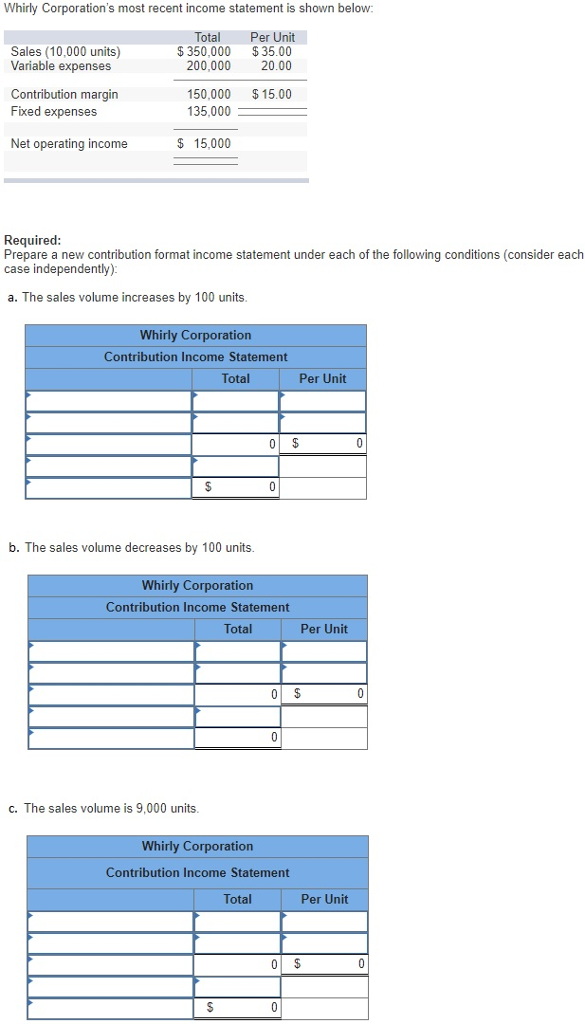
In addition, although fixed costs are riskier because they exist regardless of the sales level, once those fixed costs are met, profits grow. All of these new trends result in changes in the composition of fixed and variable costs for a company and it is this composition that helps determine a company’s profit. Contribution margin, gross margin, and profit are different profitability measures of revenues over costs. Gross margin is shown on the income statement as revenues minus cost of goods sold (COGS), which includes both variable and allocated fixed overhead costs.
The Evolution of Cost-Volume-Profit Relationships
If the company realizes a level of activity of more than 3,000 units, a profit will result; if less, a loss will be incurred. Boosting sales, however, often involves spending more money to do so, which equals greater costs. Cutting too many costs can also lead to undesirable examples of itemized deductions outcomes, including losing skilled workers, shifting to inferior materials, or other losses in quality. If the company was able to negotiate better prices with its suppliers, reducing its COGS to $500,000, then it would see an improvement in its operating margin to 50%.
Company
The difference between the selling price and variable cost is a contribution, which may also be known as gross margin. On the other hand, variable costs are costs that depend on the amount of goods and services a business produces. The more it produces in a given month, the more raw materials it requires. Likewise, a cafe owner needs things like coffee and pastries to sell to visitors. The more customers she serves, the more food and beverages she must buy.

To Ensure One Vote Per Person, Please Include the Following Info
Thus, CM is the variable expense plus profit which will incur if any activity takes place over and above BEP. Expressed as a percentage, the operating margin shows how much earnings from operations is generated from every $1 in sales after accounting for the direct costs involved in earning those revenues. Larger margins mean that more of every dollar in sales is kept as profit. It provides one way to show the profit potential of a particular product offered by a company and shows the portion of sales that helps to cover the company’s fixed costs. Any remaining revenue left after covering fixed costs is the profit generated.
Contribution Margin Ratio Calculation Example
- Operating margin considers variable costs of production as well as some indirect costs such as administration expenses of the company.
- As mentioned above, the contribution margin is nothing but the sales revenue minus total variable costs.
- Whereas, your net profit may change with the change in the level of output.
These factors can have a significant impact on the profitability of a business. Generally, the higher the operating margin ratio the better it is for the business. Then, it helps a company understand the gross profitability of a product line. The contribution margin ratio is calculated as (Revenue – Variable Costs) / Revenue. Fixed costs are often considered sunk costs that once spent cannot be recovered.
How confident are you in your long term financial plan?
This is because the breakeven point indicates whether your company can cover its fixed cost without any additional funding from outside financiers. Therefore, it is not advised to continue selling your product if your contribution margin ratio is too low or negative. This is because it would be quite challenging for your business to earn profits over the long-term. The contribution margin ratio is also known as the profit volume ratio. This is because it indicates the rate of profitability of your business. The gross sales revenue refers to the total amount your business realizes from the sale of goods or services.
One reason might be to meet company goals, such as gaining market share. Other reasons include being a leader in the use of innovation and improving efficiencies. If a company uses the latest technology, such as online ordering and delivery, this may help the company attract a new type of customer or create loyalty with longstanding customers.
A high Contribution Margin Ratio indicates that each sale produces more profit than it did before and that the business will have an easier time making up fixed costs. A low Contribution Margin Ratio, on the other hand, suggests that there may be difficulty in covering fixed costs and making profits due to lower margins on individual sales. As another step, you can compute the cash breakeven point using cash-based variable costs and fixed costs. Compare the lines for determining accrual basis breakeven and cash breakeven on a graph showing different volume levels. Cost accountants, FP&A analysts, and the company’s management team should use the contribution margin formula. CM is used to measure product profitability, set selling prices, decide whether to introduce a new product, discontinue selling a product, or accept potential customer orders with non-standard pricing.
Variable costs vary with the volume of activity, such as the number of units of a product produced in a manufacturing company. Contribution margin (CM) is a financial measure of sales revenue minus variable costs (changing with volume of activity). After variable costs of a product are covered by sales, contribution margin begins to cover fixed costs.
Companies in different industries with wildly different business models have very different operating margins, so comparing them would be meaningless. Very low or negative contribution margin values indicate economically nonviable products whose manufacturing and sales eat up a large portion of the revenues. Alternatively, the company can also try finding ways to improve revenues. However, this strategy could ultimately backfire, and hurt profits if customers are unwilling to pay the higher price. The contribution margin can help company management select from among several possible products that compete to use the same set of manufacturing resources. Say that a company has a pen-manufacturing machine that is capable of producing both ink pens and ball-point pens, and management must make a choice to produce only one of them.
Operating margin considers variable costs of production as well as some indirect costs such as administration expenses of the company. It is the ratio of the operating profit that is the profit before paying interest and taxes. It means a business can use this formula to analyze the revenue left to cover fixed costs.
